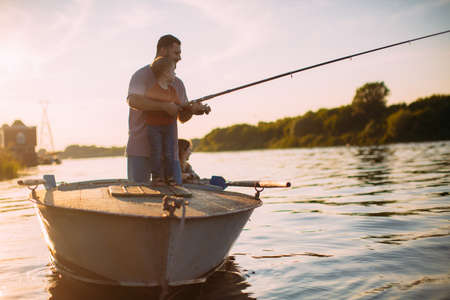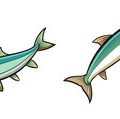Introduction to Species-Specific Line Selection
When it comes to fishing in the United States, one universal truth stands out: the line you spool up can make or break your day on the water. Every angler knows that bass, trout, walleye, and other American game fish each bring their own set of challenges—and your line is your first connection to them. Choosing the right fishing line isn’t just about picking a random spool off the rack; it’s about matching your setup to the unique habits, environments, and fight of each target species. The waters across America—from weedy Midwest lakes to rocky Appalachian streams—demand different tactics and gear. That’s why understanding species-specific line selection is key for success. Whether you’re flipping jigs for largemouth in Florida, drifting nymphs for wild trout in Colorado, or trolling crankbaits for walleye on Lake Erie, tailoring your line choice can mean the difference between landing a trophy and telling a story about the one that got away. In this guide, we’ll break down exactly how to match your line to your quarry so you can fish smarter and bring more to the boat.
Bass: Power and Precision Lines
When it comes to bass—whether you’re targeting chunky largemouth lurking in the weeds or acrobatic smallmouth patrolling rocky points—your line selection can make or break your day. Bass are notorious for smashing baits in gnarly cover, yet they’ll turn spooky when the water gets clear. Here’s a breakdown of the main line types and how to match them to your tactics:
Go-To Line Choices for Bass
| Line Type | Strengths | Best Use |
|---|---|---|
| Braid | High strength-to-diameter, zero stretch, excellent sensitivity | Flipping heavy cover, frogging, pitching jigs into grass mats |
| Fluorocarbon | Nearly invisible underwater, abrasion resistant, low stretch | Fishing clear water, finesse presentations, dragging plastics |
| Monofilament | Affordable, good shock absorption, floats well | Topwater lures, crankbaits, beginner-friendly setups |
Braided Line: Heavy Cover Specialist
If you’re punching through thick mats or working shallow timber, braid is king. Go with 50–65 lb test for heavy-duty flipping and frogging—its no-nonsense strength rips bass out of the jungle before they even know what hit ‘em. Just watch out: braid’s visibility can spook bass in gin-clear water.
Fluorocarbon: Clear Water Stealth Mode
When the bite gets tough and the lake turns into a glass bowl, fluorocarbon shines. Its near-invisible qualities fool even finicky smallmouth on deep reservoirs. Opt for 8–12 lb test for drop shotting or shaky head rigs; step up to 15–20 lb if you’re Texas rigging around sparse cover.
Monofilament: Forgiving and Floaty
Mono still has a place in any bass angler’s arsenal. Its stretch helps keep trebles pinned during topwater runs and crankbait surges. Use 10–17 lb test for most general applications—just remember mono floats, so it’s perfect for poppers and walking baits.
Tactical Tips: Flipping vs Finesse
- Flipping Heavy Cover: Pair a stout rod with 50+ lb braid. Tie directly or use a short fluorocarbon leader if you need stealth.
- Finessing Clear Reservoirs: Spool up with 6–10 lb fluorocarbon on spinning gear. Downsizing line often means more bites when bass are pressured.
- Knot Choice Matters: Palomar knots work great for braid; improved clinch knots are solid for fluoro and mono.
The right line lets you fish hard, adapt fast, and stick that kicker when it counts. Whether you’re flipping jungle-thick slop or finessing shy bass offshore, match your line to your mission—and watch your catch rate climb.
![]()
3. Trout: Finesse Tactics with Ultra-Sensitive Lines
When it comes to trout—whether you’re stalking rainbows in spring creeks, drifting for browns in mountain rivers, or casting at stocked ‘bows in your local lake—the name of the game is finesse. Trout are notorious for their sharp eyesight and wariness, especially in clear water. That means line selection isn’t just important—it’s make-or-break.
Choosing the Right Line Weight for U.S. Trout Waters
For most trout fishing situations across the U.S., you’ll want to stick with light lines. In small streams and creeks, 2-4 lb test monofilament or fluorocarbon is standard fare. This keeps your presentation natural and your casts subtle—critical when fishing for pressured wild fish or native brookies in skinny water. In larger rivers or when targeting bigger browns and rainbows, don’t be afraid to bump up to 6 lb test, but only if the water has some stain or you’re dealing with heavy current and cover.
Monofilament vs. Fluorocarbon: Know Your Options
Monofilament remains a go-to for many American trout anglers because of its stretch and forgiving nature—great for absorbing sudden runs on ultralight setups. But when the bite gets tough and the water turns gin-clear, serious trout hunters swap over to fluorocarbon leaders or even full spools. Fluoro is nearly invisible underwater and sinks faster than mono, helping tiny nymphs or light lures reach the strike zone without spooking wary fish.
Braided Line—Rarely Needed but Sometimes Useful
Braid isn’t usually necessary for trout unless you’re vertical jigging deep lakes or need long casts in wind. If you do go braid (think 8-10 lb test max), always pair it with a generous fluorocarbon leader to maintain stealth where it counts.
Adjusting for Native Trout Species Across America
The U.S. boasts a range of native trout—from Appalachian brookies to Rocky Mountain cutthroats and Pacific Coast rainbows. For these wild fish, keep everything as natural as possible: ultra-light lines, subtle presentations, and soft rod actions. Remember, what works on stockers in a city pond won’t fly on spooky natives in backcountry streams.
Bottom line: For American trout fishing, finesse trumps brute strength every time. Match your line selection to the species, water clarity, and conditions—and you’ll fool more fish than the next guy at the creek.
4. Walleye: Low-Visibility and Stretch Factors
Walleye are notorious for their keen eyesight and wariness, which makes line selection absolutely critical for success. Whether you’re vertical jigging in clear water, trolling crankbaits along rocky points, or setting up live-bait rigs on deep structure, the right line can make or break your day. Let’s break down the must-knows on clarity, diameter, and stretch for targeting these sharp-eyed predators.
Line Clarity: The Stealth Factor
When walleye fishing, especially in gin-clear lakes or pressured waters, stealth is non-negotiable. Fluorocarbon leaders—or even full fluorocarbon mainline for finesse presentations—shine due to their near-invisibility underwater. Monofilament has its place for trolling thanks to its stretch and shock absorption but can spook fish in ultra-clear conditions. Braid gives ultimate sensitivity but always pair it with a fluoro leader to keep wary walleye interested.
Diameter: Finesse vs. Power
The thinner your line, the less likely it is to be noticed by walleye. But you’ve got to balance stealth with enough strength to haul big fish out of cover or current. Here’s a quick breakdown:
| Technique | Recommended Line Type | Pound Test |
|---|---|---|
| Jigging (Clear Water) | Fluorocarbon | 6–8 lb |
| Trolling Crankbaits | Monofilament/Braid with Fluoro Leader | 10–14 lb (Mono), 10–20 lb (Braid) |
| Live-Bait Rigs | Braid Mainline + Fluoro Leader | 8–10 lb (Braid), 6–8 lb (Leader) |
Stretch: Sensitivity vs. Forgiveness
You want just enough stretch to avoid tearing hooks out of a walleye’s soft mouth but not so much that you miss subtle bites. Mono offers forgiveness when trolling or running bottom bouncers; braid gives unbeatable sensitivity for jigging—just remember that using a soft rod or fluorocarbon leader compensates for braid’s zero-stretch profile.
Quick Tips for Walleye Line Selection:
- If you’re jigging in clear water, go with straight fluorocarbon—thin diameter, low visibility.
- Trolling? Use mono for stretch and shock absorption, or braid with a long fluoro leader if you want extra depth and feel.
- Braid mainline plus a fluorocarbon leader is a killer combo for live-bait rigs—sensitive yet stealthy.
The Bottom Line:
Tailoring your line setup to match water clarity, walleye behavior, and presentation style will put more fish in your net every season. Don’t be afraid to experiment—walleye will let you know what works!
5. Additional Gamefish: Catfish, Pike, Crappie, and More
Tuning Your Line for America’s Other Heavy Hitters
When it comes to freshwater fishing in the U.S., bass and trout might grab most of the headlines, but there’s a whole roster of classic gamefish that deserve serious respect—and unique line choices. Let’s break down some quick-hit advice for dialing in your setup for catfish, pike, crappie, and more, so you’re not left wishing you’d spooled up differently after the strike.
Catfish: Muscle Up Your Mainline
American catfish—from bullhead to monster flatheads—are notorious for brute strength and dirty fighting tactics. Go heavy on your line: 15-30 lb test monofilament or abrasion-resistant braid is standard fare. Don’t skimp on leader material either; 20-40 lb mono or fluorocarbon leaders help you muscle fish out from rocks, logs, and deep cover without snapping off.
Pike & Muskie: Steel Your Nerves (and Your Leaders)
Northern pike and muskie have jaws full of razor-sharp teeth that’ll slice through light line like butter. Serious anglers run braided mainline (30-65 lb test) for power and sensitivity, paired with a steel or heavy fluorocarbon leader (at least 12-18 inches of 30-80 lb). Forget finesse—here it’s all about surviving violent strikes and toothy headshakes.
Crappie & Panfish: Keep It Light and Subtle
For slab crappie or bluegill, subtlety wins. Spool up with 2-6 lb monofilament or fluorocarbon; these lines give tiny jigs or live bait a natural presentation and let you detect soft bites. Ultra-light gear lets you enjoy every headshake while still putting slabs in the cooler.
Other Species—Walleye, Perch & Beyond: Match Tactics to Target
For walleyes and yellow perch, most anglers stick with 6-10 lb low-stretch mono or sensitive braid with a clear fluoro leader. If you’re targeting multiple species in one trip, err on the side of slightly heavier line for insurance—but always keep a spool of lighter stuff handy if the bite gets picky.
The Bottom Line: Adapt or Miss Out
No matter which American classic you’re chasing, smart line selection is your edge. Don’t just “set it and forget it”—tune your tackle to each target species’ habits and haunts. The right mainline-leader combo puts more fish on ice and fewer stories about the one that got away.
6. Environmental Considerations: Matching Line to Conditions
When it comes to bass, trout, walleye, and other freshwater targets, the environment you’re fishing in is a game-changer for line selection. In the U.S., every lake and river throws its own curveballs—water clarity, vegetation density, rocky structure, or open flats—all demanding different line strategies for each species.
Water Clarity: Stealth vs. Strength
Gin-clear water isn’t forgiving. For spooky trout or pressured bass in crystal-clear lakes like Michigan’s Torch Lake or California’s Lake Tahoe, go with low-visibility fluorocarbon leaders or main lines. Six to ten-pound test fluorocarbon keeps your presentation natural and invisible. Meanwhile, murky or stained rivers (think Mississippi backwaters) allow you to upsize to stronger mono or braid without worrying about fish shying away from heavy line.
Vegetation: Cutting Through the Jungle
If you’re flipping jigs into thick hydrilla mats for largemouths in Florida or Texas reservoirs, braided line is king. Its no-stretch construction slices through grass and gives you the muscle to yank lunkers out of heavy cover. For northern pike lurking in weedy bays, 30-50 lb braid with a fluorocarbon leader stands up to abrasive stems and toothy strikes.
Structure: Rocks, Timber, and Docks
Fishing rocky ledges for smallmouth on Lake Erie? Abrasion resistance becomes crucial. Here’s where tough copolymer mono or abrasion-resistant fluoro shines—protecting your line from sharp rocks and zebra mussels. Around timber or dock pilings (prime haunts for both bass and crappie), heavier mono (15-20 lb) absorbs shock if a fish wraps you up during the fight.
Adapting by Species
Bass: Adapt to heavy cover with braid; downsize in clear water with fluoro.
Trout: Favor light fluorocarbon in clear streams; bump up diameter when targeting bigger browns in swift water.
Walleye: Use thin-diameter mono or fluoro for finesse presentations over sand flats; switch to abrasion-resistant options around rock piles.
Panfish/Crappie: Ultralight mono excels around docks but consider light braid when fishing brush piles to feel subtle bites.
Bottom line: Always match your line not just to the target species, but also to what Mother Nature is throwing at you in each unique American waterway. The right choice means more hookups—and fewer heartbreaks when a trophy fish takes you into the jungle.
7. Real-World Tips and Common Mistakes
Hard-Earned Advice from the Water
Ask any seasoned American angler: picking the right line is more than just matching pound test to your rod. It’s about reading the water, knowing your target species, and learning from years of trial and error. For bass, don’t be afraid to bump up to 15-20lb braided mainline with a fluorocarbon leader if you’re pitching into heavy cover—bass busting through lily pads will snap light mono without a second thought. Trout chasers, especially in clear Appalachian streams, swear by ultra-thin 4-6lb fluorocarbon for stealthy presentations. Walleye guys in Minnesota? Many have switched to low-stretch superlines for improved bite detection on deep jigging rigs. The key: match your line not just to the fish, but also to local conditions and tactics.
Common Line Selection Blunders
One of the most common rookie mistakes is using line that’s too heavy “just in case.” This kills lure action and spooks pressured fish, especially trout and finicky bass. On the flip side, running too light can leave you heartbroken when that trophy walleye snaps you off at the boat. Another blunder is ignoring line visibility—clear water means low-vis lines or leaders are a must. Many also forget to check for abrasion resistance when fishing rocky rivers or around docks; cheap mono gets shredded fast.
Trouble Signs: What to Watch For
If your topwater bass frog isn’t walking right, or your trout spoon keeps spinning out on the cast, your line may be too thick or have too much memory. Frayed spots near knots or frequent break-offs? Time to retie or swap spools. Don’t ignore odd casting sounds or sudden loss of sensitivity—those are red flags that it’s time for fresh line or a different type altogether.
What’s Hot in American Tackle Shops Right Now
Walk into any big-box sporting goods store or indie tackle shop across the U.S., and you’ll see a trend: braid-to-fluorocarbon combos are hot for everything from largemouths in Texas lakes to smallmouths in Michigan rivers. Premium brands like PowerPro, Seaguar, and Sufix dominate shelves, with specialty lines for specific fisheries (think ice fishing braids or finesse fluoros). Anglers are also demanding UV-resistant coatings and color-coded depth-marked lines for precision trolling. The bottom line? Stay informed, experiment with new tech, but never abandon hard-won basics—it’s the blend of old-school wisdom and modern gear that puts more fish in the boat.


